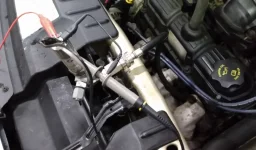Backstory - 2005 Dodge Grand Caravan, 190k miles, loss of power, transmission won't shift into drive unless you let completely off the accelerator, excessive "hissing/whistling" that sounds like an exhaust leak. I'm thinking the catalytic converter or exhaust system is plugged but want to verify before throwing parts at it.
I borrowed a pressure transducer from work (10vdc output at 300 psi) and cobbled up a mess of fittings to adapt it to my compression tester (after removing the Schrader valve). Now I've never captured or analyzed an in-cylinder pressure waveform before, but if I've correctly identified the exhaust valve opening then I'm seeing 492mV or about 14.8 psi at idle. At 2500 rpm, pressure increases to about 512mV or about 15.4 psi. So unless there is something I'm missing, I'm thinking this confirms a plugged exhaust.
Thoughts?
I borrowed a pressure transducer from work (10vdc output at 300 psi) and cobbled up a mess of fittings to adapt it to my compression tester (after removing the Schrader valve). Now I've never captured or analyzed an in-cylinder pressure waveform before, but if I've correctly identified the exhaust valve opening then I'm seeing 492mV or about 14.8 psi at idle. At 2500 rpm, pressure increases to about 512mV or about 15.4 psi. So unless there is something I'm missing, I'm thinking this confirms a plugged exhaust.
Thoughts?


